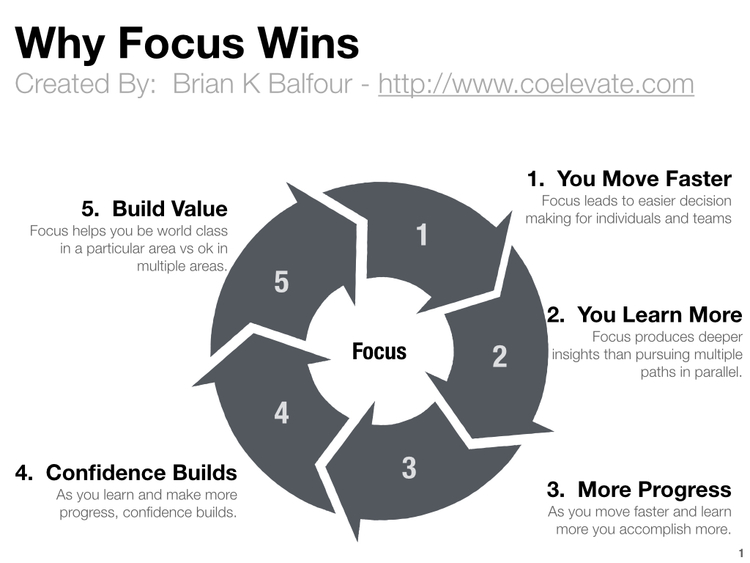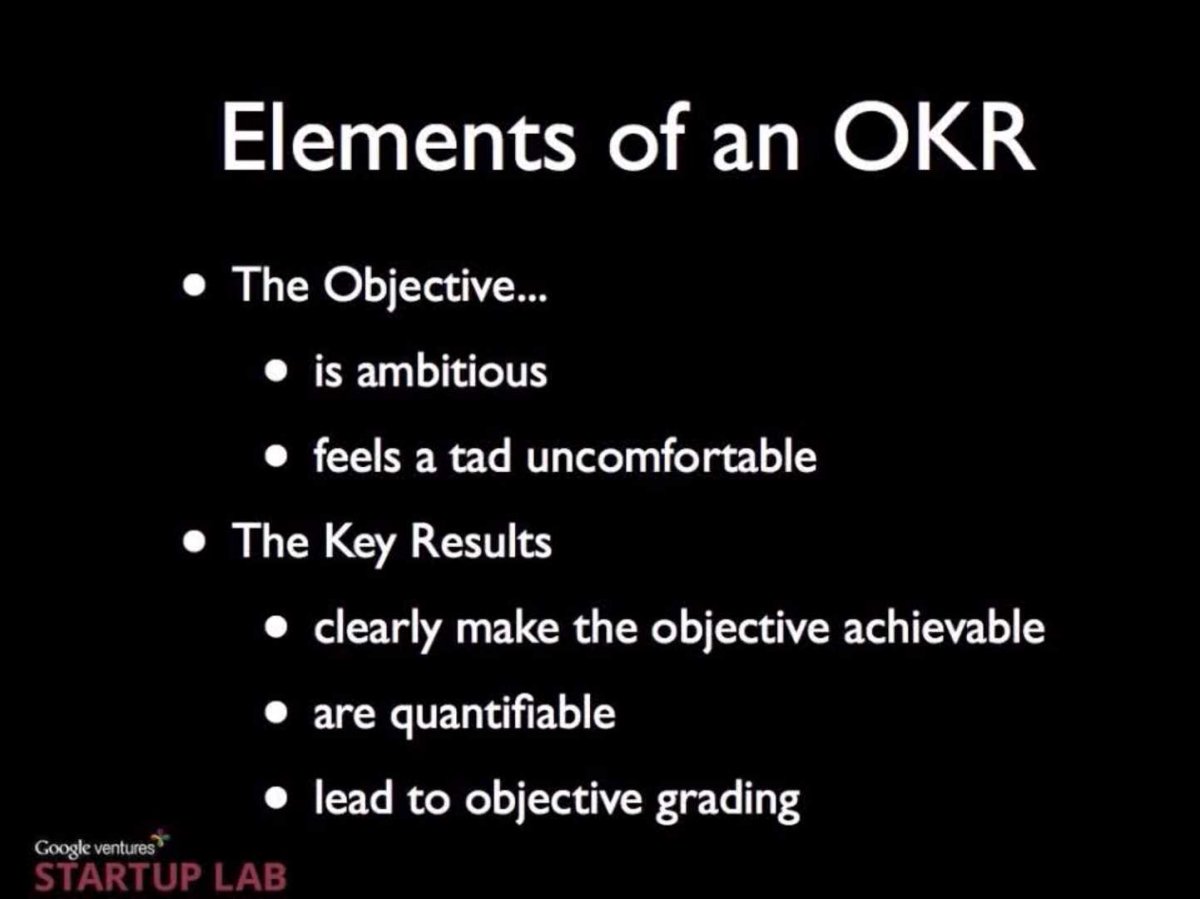Nonprofit leadership often means taking on the world, including attempting to solve every tiny problem along the way. While it may seem like each solution is a step toward reaching your organization’s ultimate mission, this do-it-all approach may actually be hurting your nonprofit.
In our world of nonstop communication, where streams of information are coming at you from all directions, it’s hard not to multitask. But the reality is, multitasking often results in mediocrity.
“It’s hard not to multitask. But the reality is, multitasking often results in mediocrity…” tweet this
The Importance Of Focus
Research shows that our short term memory can only handle five to nine different things at any given time. And those are small things. When attempting to accomplish two tasks that both require the same level of engagement, your mind can’t fully process information from either task.
So, if multitasking doesn’t work, then what does? Brian Balfour, CEO of Reforge and former vice president of growth at Hubspot, says his success as a business leader lies in the power of focus. The word focus is often tossed around leadership circles, but the question many leaders ask is, “how can focusing on one task really benefit my organization?”

To understand the importance of focus, Balfour suggests first understanding what focus means to organizational leaders.
In this case, focus means identifying one long-term goal that is meaningful to your nonprofit, narrowing down your tasks to focus on the most important thing you should be doing right now to achieve that goal, doing that task for long enough to gather credible data, and adjusting your long-term goal based on the data you collect.
“Focus means identifying one long-term goal that is meaningful to your nonprofit…” tweet this
The ONE Question
To determine your long-term goal, start with your organization’s mission. But when attempting to set an actionable goal, you can’t just plug in your mission statement verbatim. Instead, think SMART — your goal should be Specific, Measurable, Attainable, Relevant, and Timely.
Even with those guidelines in place, it may be difficult to narrow your focus to a single long-term goal for your organization. To assist in finding your focus, author Gary Keller (The One Thing: The Surprisingly Simple Truth Behind Extraordinary Results) suggests asking yourself this question: “What’s the one thing you can do such that by doing it, everything else will be easier or unnecessary?”
The next step is outlining the tasks you, as a leader, and your organization as a whole needs to embark upon to achieve your SMART goal using what Keller calls “the domino effect.” Once you figure out the one long-range goal, you must then identify the number of dominoes you need to line up in order to make that goal happen.
 To narrow your row of dominos further, apply the 80/20 principle (Pareto Principle) — the minority of your effort goes toward the majority of your results (ex: 80 percent of your nonprofit’s donations typically come from 20 percent of your donor base).
To narrow your row of dominos further, apply the 80/20 principle (Pareto Principle) — the minority of your effort goes toward the majority of your results (ex: 80 percent of your nonprofit’s donations typically come from 20 percent of your donor base).
Applying this principle to focus means taking a look at your to-do list and pulling out the tasks that have the biggest impact on your ultimate success. Focusing on these key activities will help you achieve greater results by focusing your attention only on activities that progress you toward your ultimate goal.
But don’t stop at 80/20! To achieve ultimate focus, Keller recommends taking this idea even further and whittling down your list by 20 percent (and then 20 percent again) until only a vital few tasks remain. This allows you to narrow your focus and place your undivided attention on the task at hand.
The Benefits Of Focus
This sort of focus takes a great deal of discipline, but those who have accomplished it say the results are worth the effort. Based on research, it takes about 66 days to turn a disciplined act into a habit. Balfour noticed five key advantages of the discipline of focus:
 First of all, you move faster, which means less energy and time is put into the act of deciding and more of your attention can be placed into putting your decision into action. Balfour says, “With focus, the decision between multiple options comes down to one simple question. Which one contributes to our focus the most?”
First of all, you move faster, which means less energy and time is put into the act of deciding and more of your attention can be placed into putting your decision into action. Balfour says, “With focus, the decision between multiple options comes down to one simple question. Which one contributes to our focus the most?”
Secondly, you learn more. When focusing on one task at a time, you dig deeper into the subject matter and gain a better grasp on the focus subject. Additionally, your mind is able to retain the information you gather, which you can use at a later time.
Making quick decisions and retaining the information you learn from those decisions helps you make more progress toward your ultimate goal. “It seems the best way to get nothing done is to try and get everything done at once,” Balfour notes.
And this quick progression helps you build confidence, which also makes you a more valuable asset to your organization.
While Balfour points out the personal growth you could experience by learning to focus, Keller sees how your organization as a whole can benefit from a focused leader. The author uses a framework called “iceberging” to demonstrate how purpose (or focus) affects an organization’s priorities, productivity and profit.

In Keller’s diagram, there are four parts to an iceberg: purpose, priority, productivity and profit. Purpose (or mission in the case of a nonprofit) forms the basis of the iceberg, as well as the foundation on which your organization is built.
On top of purpose is priority. Here is where focus begins to come into play. In this stage, you must focus on one priority at a time. To determine where your priority should lay, ask yourself the ONE question and continue from there.
The layers above the water (productivity and profit) are the parts most businesses focus on, but they’re much less important than the foundation on which they are built. Productivity is the result of a clear purpose and a solid priority — and higher productivity ultimately leads to higher profit (or more donations!).
The Difficulties of Focus
Now we can see why focus is such an important leadership characteristic. So why don’t most executives focus?
Balfour suggests many leaders struggle with choosing a focus, sticking to one focus once their priority is set, and even knowing when to abandon a focus when it’s clearly not working out.
Keller, on the other hand, notes that many leaders fall prey to the “four thieves of productivity:”
- The inability to say no — Keller recommends saying yes only to opportunities that further your one goal
- Fear of chaos — Instead of being afraid of the chaos, you must learn to control it in your own way. Don’t let it control you.
- Environment doesn’t fit your goals — Surrounding yourself with like-minded individuals will help you achieve your one goal. If you find other members of your organization are distracting you from your nonprofit’s priority, consider discussing your concerns with them and emphasizing the importance of your focus as the organization’s leader.
- Poor health habits — Focusing on one priority doesn’t mean taking a focus off yourself. In addition to making an effort to maintain focus within your organization, consider incorporating healthy habits into your time outside of work. Things like meditation, regular exercise, eating right and getting a sufficient amount of sleep will ensure you maintain physical health. But your mental health is just as important. Planning and goal setting go a long way in improving mental energy, while spending quality time with family and friends can enhance your emotional well-being.
In fact, many leadership experts say this inward focus helps leaders develop emotional intelligence, a quality that begins with self-awareness. The ability to listen to your inner voice begins by taking care of your physical and emotional needs, in addition to the needs of your organization.
This inner focus can help develop your cognitive control, or your ability to self-restrain. These qualities make focusing on the needs of others and the needs of your organization a little simpler by allowing your to hone your cognitive empathy and systems awareness.
Implementing Organizational Focus
While personal development such as this is essential in enhancing your own leadership skills, your role as a nonprofit leader will also require you to inspire focus in your staff and volunteers. There are several tools at your disposal to assist in this task, but two, in particular, stand out from the crowd.
An MSPOT document, created by HubSpot, is a simple guideline that can be easily disseminated to your employees and volunteers. It outlines the details of your organizational focus simply and clearly, making sure everyone is on the same page. The document includes five key components:
- Mission: rarely changes
- Strategy: changes annually based on data collected from your “dominos”
- Projects: the “dominos” you choose to complete to further your mission
- Omissions: the “dominos” you didn’t choose
- Tracking: the data you are collecting to determine if your strategy is working
Google also uses an organization-wide system to determine its goals, called Objectives and Key Results, or OKRs. While the system varies from company to company, most OKRs include objectives, which are set quarterly at a personal, team and organizational level. These goals also include expected results, which must be 100 percent measurable.
 The beauty of OKRs is that they can be adjusted to fit your organization’s needs. While larger nonprofits may benefit from creating an organization-wide OKR, then creating offshoots for each department. Smaller groups may do well working with one document. The document itself can be as simple as an Excel spreadsheet or as detailed as a Trello board.
The beauty of OKRs is that they can be adjusted to fit your organization’s needs. While larger nonprofits may benefit from creating an organization-wide OKR, then creating offshoots for each department. Smaller groups may do well working with one document. The document itself can be as simple as an Excel spreadsheet or as detailed as a Trello board.
No matter the tools you choose to implement your plan, the first step toward becoming a focused leader is the most important. The decision to focus will provide you with a map for your journey, and maintaining that focus throughout the trip will result in a better, more efficient organization that will most definitely make its mission a reality.
“The first step toward becoming a focused leader is the most important…” tweet this
If you liked this article, you may also like:
6 Inspiring TED Talks Nonprofit Leaders Must Watch
Nonprofit Fundraising Plan: 6 Must-Do Steps For Success
Editor's Picks
Ultimate Guide To Peer-to-Peer Fundraising
Customer Story: Spur Local Raises Over $1M With Their Give Local Campaign
Fundraising Strategies for Nonprofits: Craft the Best Approach for Your Organization
Create a Killer Fundraising Plan - Best Practices, Strategies, & Downloadable Template



